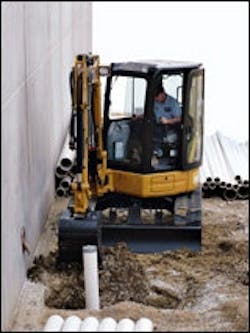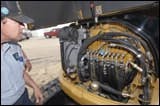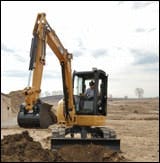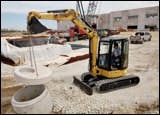Mini-Excavator Gains "Real-Machine" Status
Our friend Gene Held has been moving dirt for 30-plus years — many years with contractors, and more recently as an instructor in Local 150's (International Union of Operating Engineers) Apprenticeship and Skill Improvement Program. Held's primary job is to help young apprentices become competent, safety-conscious operators of hydraulic excavators and backhoe-loaders, so it's to him we turn when we have a new machine of this type to evaluate.
We worked with Held most recently in late April, when Caterpillar's Matt Mumford arranged with nearby dealer Patten Equipment to deliver a brand new 304C CR (Compact Radius) mini-excavator to Local 150's new training facility (presently under construction) near Wilmington, Ill. Although Mumford wanted to supply a 304C with its optional coupler and optional hydraulic thumb, the machine arrived with a standard pin-on bucket. The mini-excavator market is so hot these days, explained Mumford, that choices for our evaluation machine were limited.
Equipped with a cab (optional), air-conditioning (optional), rubber tracks, blade and counterweight (as was our test machine), the 304C CR weighs in at about 10,800 pounds. The mini-excavator, which is manufactured by Caterpillar in Japan, is powered by a 42-hp (net), Tier-2-compliant Mitsubishi diesel. The standard digging arm (stick) yields a maximum digging depth of 10 feet 10 inches, and the "long arm" (which our machine used) delivers 12 feet 1 inch. Both sticks are available from the factory with integral mounting bosses that facilitate installation of the optional hydraulic thumb.
The 304C has a "CR" designation, because the standard rear counterweight can overhang the tracks by up to 4 inches. The counterweight is installed to improve lifting performance, which, says Caterpillar, may be compromised to a degree in some zero-tail-swing designs. If need be, the counterweight can be removed to provide zero tail swing.
Probably like many professional equipment operators with years of experience, Held admits that he didn't take the mini-excavator too seriously when it first appeared on the North American construction scene. But he's changed his tune, he says, based mainly on the performance of a couple of mini models added to Local 150's fleet in the recent past.
"It's amazing how much power these little things have," says Held. "When they first came out on the market, I thought: 'Those little toys, what the heck would you want one of those for?' But they really are strong, versatile machines, and now you see them everywhere."
So, now that we knew Gene wasn't going to be a hard sell on the mini-excavator concept, Mumford gave us a quick tour of the 304C's cabin. Held's observations as he climbed into the cab were, first, the sliding door, which he considered an excellent feature, and then, as he settled into the seat, the machine's excellent all-around visibility. Mumford asked Held to unlatch the front window and slide it upward into the roof, an operation easily done with the assistance of gas struts, and then to remove the lower front glass, which lifts easily out of its frame for storage against the left rear window.
"When it's warm, I like the bottom glass out," says Held, "because it's usually dirty and you can't see as well into the trench. This is an easy-to-use system. Some front windows you really have to tug at."
Mumford explained that a significant design change for the 304C (compared to its predecessor) was the replacement of foot pedals — for boom swing and auxiliary hydraulics — with thumb controllers in the pilot-operated joysticks. The net result, he said, is easier control of these functions and more foot room.
"Foot room is important," said Held. "I don't like operating with my knees under my chin."
Our test machine was equipped with a push blade (it's standard), and the pilot-operated blade controller has a forward detent to place the blade in a float condition. Soon to be available, Mumford said, is a hydraulic angle blade that can be rotated 25 degrees right or left to minimize repositioning when backfilling. The new blade's controller will be single-lever and pilot-operated.
When Held noted the two-speed travel switch on the 304C's panel, Mumford pointed out that the travel system now has automatic-shift capability. You can place the switch in the "rabbit" position, he said, and the system will automatically downshift when it encounters a load — or when the machine turns. He noted, too, that the 304C now has an auto-idle feature, which is aimed, he says, at enhancing fuel economy and lowering sound levels.
When Mumford told Held that the 304C was radio-ready, we asked Held if he liked a radio when he was working.
"No, I seldom use it. The kids [his apprentices] do — they like jammin' when they're operating. But I don't. I'm from the old school, so I like to concentrate on what I'm doing. A radio's nice sometimes if you're out by yourself, but I want to hear how the machine's running, so if something goes wrong, I'm aware of it. But that's just one guy's opinion."
The 304C is fitted with auxiliary hydraulics as standard equipment, and our test machine, Mumford told us, also was fitted with an optional auxiliary package that allows, for example, use of a rotating shear. The secondary auxiliary functions, he explained, work off the boom-swing circuit, and an in-cab switch diverts oil from one function to the other. A changeover valve in the engine compartment allows the main auxiliary hydraulics to function as either a one-way or two-way system.
When we put the 304C to work, we first asked Held to position the machine's tracks parallel with the wall of the new facility, then to position the cab and boom so as to dig closely parallel to the wall. The intent was to get his thoughts on this compact machine's basic maneuverability and controllability. After 10 minutes or so, we asked what he thought.
"The offset boom gives the machine a lot of flexibility; it's great for working in tight quarters like this. Hydraulic functions are very smooth and easy to feather — not jerky at all — and that's important when you're working against a structure that you dare not damage."
The next exercise was trenching in a moist, heavy-clay stockpile. As we watched Held work, our overall observations were that 304C seemed quite a flat-footed digger (it has more track-on-ground than its predecessor) and that its digging motion was consistently smooth. Mumford told us that Cat excavators, mini-models included, are known for high stick forces, and now, he said, bucket-breakout force also has been significantly increased in the new C-Series. But what did Held think about 304C's trenching performance?
"It's got a lot of breakout power in the stick, and that's what I like. When you're coming in with the stick, you don't want to have to pump the bucket to get through the cut. It's also very smooth; you could finish grade with it."
How about stability when you were pulling through some of the tough spots?
"It was very stable — as long as you have the blade down in front. I noticed, too, that even with the longer stick, when you come up out of the hole, you don't get into the blade with the bucket. On some machines, especially those with an extendible stick, you can hit the blade if you're not careful."
Next, Held used the 304C's blade to backfill the trench.
"It's got plenty of pushing power," he said, "and blade control is smooth. And when you put the blade into the dirt, it doesn't dive into the cut. Some machines will do that, and you're always having to pull the blade up."
As a final exercise, Held placed a chain through the 304C's lifting eye (which is integral with the bucket link) and picked the top ring of a concrete manhole.
"It has good lifting power," he said. "I don't know what that ring weighs, but I'll bet that I could have lifted the bottom section, too, if we had the rigging to hook it up. I could raise the blade and travel with the load, and it didn't feel unstable at any point."
We then found a shorter chain that allowed making the same pick and keeping the load tucked in sufficiently to swing over the side. Again, according to Held, the machine was strong and stable, "as long as you keep the load in close and keep the blade down."
What impressed us, also, is the precision with which Held could replace the massive ring over the neck of the manhole — likely the result of his skill and the machine's controllability.
Mumford told us that Caterpillar's primary focus when developing the C-Series mini-excavators was to continue to enhance operator comfort (hence the larger cab with its new amenities) and to increase digging performance (which seemed to impress Held).
So, Gene, do you have any parting thoughts about this mini?
"I'll come back to the stick power it has. I like to dig only to about the height of the teeth, and to move the stick though an arc from about the 8-o'clock position to the 5-o'clock position.
"Because I'm not digging deep, I can feel the bottom of the trench. Some guys will just roll the bucket into the ground to load it, but you'll never dig around utilities doing that. You always want to shelf the material down. This machine has the power to dig the way I want. I think Cat has done well on this particular machine."






